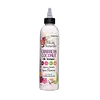What's inside
What's inside
 Key Ingredients
Key Ingredients

 Benefits
Benefits

 Concerns
Concerns

 Ingredients Side-by-side
Ingredients Side-by-side

Water
Skin ConditioningSodium C12-13 Pareth Sulfate
CleansingCocamidopropyl Betaine
CleansingSodium Chloride
MaskingTocopheryl Acetate
AntioxidantAscorbic Acid
AntioxidantPanthenol
Skin ConditioningBiotin
AntiseborrhoeicNiacinamide
SmoothingDimethiconol
EmollientParfum
MaskingCitric Acid
BufferingGlycerin
HumectantSodium Benzoate
MaskingGlycol Distearate
EmollientCarbomer
Emulsion StabilisingSodium Laureth Sulfate
CleansingTea-Dodecylbenzenesulfonate
CleansingCocamide Mea
EmulsifyingGuar Hydroxypropyltrimonium Chloride
Skin ConditioningDisodium EDTA
PEG-45m
HumectantPPG-9
Skin ConditioningAmyl Cinnamal
PerfumingBenzyl Alcohol
PerfumingLimonene
PerfumingLinalool
PerfumingMica
Cosmetic ColorantCI 77891
Cosmetic ColorantWater, Sodium C12-13 Pareth Sulfate, Cocamidopropyl Betaine, Sodium Chloride, Tocopheryl Acetate, Ascorbic Acid, Panthenol, Biotin, Niacinamide, Dimethiconol, Parfum, Citric Acid, Glycerin, Sodium Benzoate, Glycol Distearate, Carbomer, Sodium Laureth Sulfate, Tea-Dodecylbenzenesulfonate, Cocamide Mea, Guar Hydroxypropyltrimonium Chloride, Disodium EDTA, PEG-45m, PPG-9, Amyl Cinnamal, Benzyl Alcohol, Limonene, Linalool, Mica, CI 77891
Water
Skin ConditioningAloe Barbadensis Leaf Juice
Skin ConditioningGlycerin
HumectantCocos Nucifera Oil
MaskingCocos Nucifera Shell Powder
AbrasiveRosmarinus Officinalis Leaf Oil
MaskingSalvia Officinalis Leaf Extract
CleansingUrtica Dioica
Prunus Amygdalus Dulcis Oil
Skin ConditioningSimmondsia Chinensis Seed Oil
EmollientMelaleuca Alternifolia Leaf Oil
AntioxidantTocopherol
AntioxidantPersea Gratissima Oil
Skin ConditioningParfum
MaskingWater, Aloe Barbadensis Leaf Juice, Glycerin, Cocos Nucifera Oil, Cocos Nucifera Shell Powder, Rosmarinus Officinalis Leaf Oil, Salvia Officinalis Leaf Extract, Urtica Dioica, Prunus Amygdalus Dulcis Oil, Simmondsia Chinensis Seed Oil, Melaleuca Alternifolia Leaf Oil, Tocopherol, Persea Gratissima Oil, Parfum
Ingredients Explained
These ingredients are found in both products.
Ingredients higher up in an ingredient list are typically present in a larger amount.
Glycerin is already naturally found in your skin. It helps moisturize and protect your skin.
A study from 2016 found glycerin to be more effective as a humectant than AHAs and hyaluronic acid.
As a humectant, it helps the skin stay hydrated by pulling moisture to your skin. The low molecular weight of glycerin allows it to pull moisture into the deeper layers of your skin.
Hydrated skin improves your skin barrier; Your skin barrier helps protect against irritants and bacteria.
Glycerin has also been found to have antimicrobial and antiviral properties. Due to these properties, glycerin is often used in wound and burn treatments.
In cosmetics, glycerin is usually derived from plants such as soybean or palm. However, it can also be sourced from animals, such as tallow or animal fat.
This ingredient is organic, colorless, odorless, and non-toxic.
Glycerin is the name for this ingredient in American English. British English uses Glycerol/Glycerine.
Learn more about GlycerinParfum is a catch-all term for an ingredient or more that is used to give a scent to products.
Also called "fragrance", this ingredient can be a blend of hundreds of chemicals or plant oils. This means every product with "fragrance" or "parfum" in the ingredients list is a different mixture.
For instance, Habanolide is a proprietary trade name for a specific aroma chemical. When used as a fragrance ingredient in cosmetics, most aroma chemicals fall under the broad labeling category of “FRAGRANCE” or “PARFUM” according to EU and US regulations.
The term 'parfum' or 'fragrance' is not regulated in many countries. In many cases, it is up to the brand to define this term.
For instance, many brands choose to label themselves as "fragrance-free" because they are not using synthetic fragrances. However, their products may still contain ingredients such as essential oils that are considered a fragrance by INCI standards.
One example is Calendula flower extract. Calendula is an essential oil that still imparts a scent or 'fragrance'.
Depending on the blend, the ingredients in the mixture can cause allergies and sensitivities on the skin. Some ingredients that are known EU allergens include linalool and citronellol.
Parfum can also be used to mask or cover an unpleasant scent.
The bottom line is: not all fragrances/parfum/ingredients are created equally. If you are worried about fragrances, we recommend taking a closer look at an ingredient. And of course, we always recommend speaking with a professional.
Learn more about ParfumWater. It's the most common cosmetic ingredient of all. You'll usually see it at the top of ingredient lists, meaning that it makes up the largest part of the product.
So why is it so popular? Water most often acts as a solvent - this means that it helps dissolve other ingredients into the formulation.
You'll also recognize water as that liquid we all need to stay alive. If you see this, drink a glass of water. Stay hydrated!
Learn more about Water